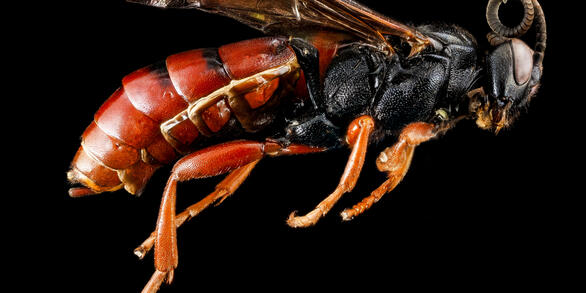Untapped Capacity: Our 4,000 Species of Native Bees
Untapped Capacity: Our 4,000 Species of Native BeesSo many unknowns and so many potentials.

An official website of the United States government
Here's how you know
Official websites use .gov
A .gov website belongs to an official government organization in the United States.
Secure .gov websites use HTTPS
A lock () or https:// means you’ve safely connected to the .gov website. Share sensitive information only on official, secure websites.
The USGS Bee Lab supports research on native bees. As part of that program we and our co-located USFWS partners develop identification tools and keys for native bee species, take public access hi resolution photographs of bees, work with partners from all the states of the unions, design and test bee counting techniques and document bee/plant associations as well as double checking researchers identification of native bee species. Our goal is to assist those who do research on native bees to increase their ability to research bees accurately and efficiently. We are the only group in the Department of the Interior who currently has the expertise to identify native bees to species.

Discover Life - free on-line tools to identify species, teach and study nature's wonders, report findings, build maps, process images, and contribute to and learn from a growing, interactive encyclopedia of life with 1,385,843 species pages and 778,580 maps.
Discover Life - Identification - Start the identification process by determining the bee genus you have by using this guide
Handy Bee Manual: How to Catch and Identify Bees and Manage a Collection - A Collective and Ongoing Effort by Those Who Love to Study Bees in North America
Social Media
5,000 Ultra Hi-Res Public Domain Images from our USGS Bee Lab - This Flickr site is designed to provide easy access to our photographs so that they may be freely used. There is no need to ask for our permission for any use of these photographs.
USGS Bee Lab - Follow us on Tumblr includes detailed information about bee species
USGS Bee Lab - Follow us on Instagram and enjoy our photography and stories about bees and the laboratory.






Below are other science projects associated with this project.
Below are multimedia items associated with this project.
 Untapped Capacity: Our 4,000 Species of Native Bees
Untapped Capacity: Our 4,000 Species of Native Bees
So many unknowns and so many potentials.
So many unknowns and so many potentials.

Species occurrence records for native and non-native bees, wasps and other insects collected using mainly pan, malaise, and vane trapping; and insect netting methods in Canada, Mexico, the non-contiguous United States, U.S. Territories (specifically U.S. Virgin Islands), U.S. Minor Outlying Islands and other global locations.
Below are news stories associated with this project.
Below are partners associated with this project.
The USGS Bee Lab supports research on native bees. As part of that program we and our co-located USFWS partners develop identification tools and keys for native bee species, take public access hi resolution photographs of bees, work with partners from all the states of the unions, design and test bee counting techniques and document bee/plant associations as well as double checking researchers identification of native bee species. Our goal is to assist those who do research on native bees to increase their ability to research bees accurately and efficiently. We are the only group in the Department of the Interior who currently has the expertise to identify native bees to species.

Discover Life - free on-line tools to identify species, teach and study nature's wonders, report findings, build maps, process images, and contribute to and learn from a growing, interactive encyclopedia of life with 1,385,843 species pages and 778,580 maps.
Discover Life - Identification - Start the identification process by determining the bee genus you have by using this guide
Handy Bee Manual: How to Catch and Identify Bees and Manage a Collection - A Collective and Ongoing Effort by Those Who Love to Study Bees in North America
Social Media
5,000 Ultra Hi-Res Public Domain Images from our USGS Bee Lab - This Flickr site is designed to provide easy access to our photographs so that they may be freely used. There is no need to ask for our permission for any use of these photographs.
USGS Bee Lab - Follow us on Tumblr includes detailed information about bee species
USGS Bee Lab - Follow us on Instagram and enjoy our photography and stories about bees and the laboratory.






Below are other science projects associated with this project.
Below are multimedia items associated with this project.
 Untapped Capacity: Our 4,000 Species of Native Bees
Untapped Capacity: Our 4,000 Species of Native Bees
So many unknowns and so many potentials.
So many unknowns and so many potentials.

Species occurrence records for native and non-native bees, wasps and other insects collected using mainly pan, malaise, and vane trapping; and insect netting methods in Canada, Mexico, the non-contiguous United States, U.S. Territories (specifically U.S. Virgin Islands), U.S. Minor Outlying Islands and other global locations.
Below are news stories associated with this project.
Below are partners associated with this project.
